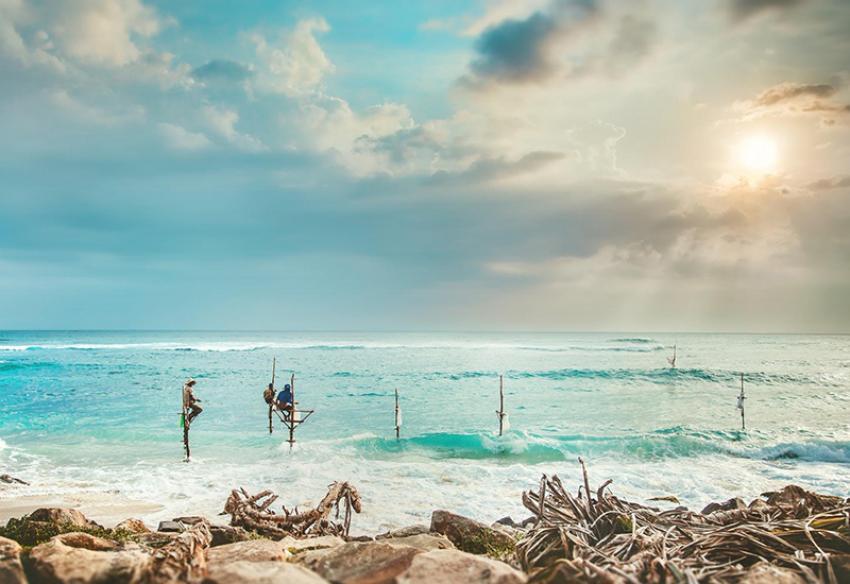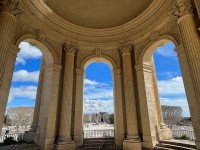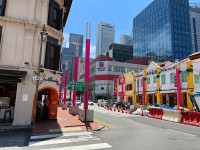 Image: Pixabay
Image: Pixabay
Sri Lanka: The Indian Ocean magnet for explorers
Sri Lanka is in the news for all the wrong reasons these days. But this tourist magnet reeling under economic and political turmoil is sure to make it back on the bucket list of global travellers for its innate beauty and spirituality, says Supriyo Hazra as he completes a weeklong visit to the island nation which began in Colombo and ended in Galle
Standing at the top of the Lotus Tower, the 350-metre-tall structure located in the heart of Colombo, I was relishing a silence which was only broken by the strong winds crashing on me. A 360 degree view of Colombo from the top is sure to be etched in my mind forever. You can sense that unlike the picturesque destination of Nuwara Eliya, which is a creation of God and was in my itinerary in the coming days, Colombo is one modern city built to perfection by the Islanders over the passage of time.
The Lotus Tower, the aerial view and everything surrounding Colombo, will create a magical spell in your minds on the very first day of your visit to the island nation.
.jpg)
Lotus Tower, Colombo. Image: Unsplash
Colombo: A city of varied colours
Getting a visa to visit Sri Lanka from India is a fairly easy task. As you arrive in Colombo you should surely try to put up in a good hotel that suits your budget. I was lucky to be hosted by one of the finest hotels in the city- the iconic Galle Face Hotel. Built in 1864, the hotel is one of the luxurious properties located in the east of Suez. After checking-in, I headed towards my first destination in the city- Pettah Market.
.jpg)
Pettah Market. Image: Unsplash
Like any other busy city, Colombo too hides within its heart a busy marketway where you should move around and be amazed by the hustle and bustle of it. If you search in the internet about the must do things in Colombo then visiting this market remains one recommendation.
There is surely a charm hidden in the winding roads of the market. You will find that every corner of it holds one unique surprise. Once you reach the centre of the market, you will find myriad shops, eateries, street vendors, playing their own parts to add to the unique charm of the spot for the leisurely traveller.
Once you complete your quick shopping, you may walk towards one of the train stations and witness the serpentine movement of the trains that connect hundreds of people who arrive in the Sri Lankan capital everyday from the nearby regions.
.jpg)
Image: Unsplash
Infact, in many cities across Sri Lanka, you will find railways playing an integral part of the lifestyle and transport system.
.jpg)
If you look up the Sri Lankan Railways website then you will find rail was introduced in Sri Lanka in 1864 to transport coffee from plantations in the hill country district of Kandy to the port city of Colombo on its way to Europe and the world market. So, once you reach one of the railway stations, you should not forget to sit for a while and reflect on a bygone colonial era.
In the late evening, once you are done with your visit to the Pettah Bazar and a railway station, you can finish the day by visiting the nearest shopping mall and enjoy the way today's people in Colombo love to buy their products.
The bright coloured, multi-storeyed plush shopping malls, like in any other capital cities across the world, keep within it a leisurely charm for shoppers to quench their shopping thirst.
.jpg)
Galle Face Mall was the place where I visited to experience the vibe of a late Sunday evening in Colombo when shoppers were seen busy striking the last moment deal to choose their favorite merchandise. Located close to the city centre, this shopping mall was a 15-minute walking distance from my hotel, with the sea accompanying all throughout the walk.
In Colombo, you should also visit the Kelaniya Raja Maha Vihara, a popular pilgrimage destination in the city. You may also visit the Vibhishana Temple present inside the premises.
Even though Kelaniya is a Buddhist Temple in Sri Lanka, there is a direct link between mythological tales of Ramayana in Sri Lanka and Kelaniya Buddhist Temple.
Ramayana states that after the death of Ravana, the demon King as mentioned in Ramayana, Vibhishana was crowned by Lakshmana (brother of Hindu deity Rama). Kelaniya is the place which had been ruled by Vibhishana.
Hence, Kelaniya Buddhist Temple is also considered as an important site of Ramayana tour of Sri Lanka.
King Vibhishana, who was considered a righteous king, had supported Rama against his own brother’s injustice. Many devotees that visit king Vibhishana ’s shrine even today also pray to him and ask for his intervention in solving their problems.
.jpg)
The Kelani River has been mentioned in the legends of Ramayana by Valmiki as Vibhishana ’s palace was said to be on the banks of this river. King Vibhishana is still considered as one of the four guardian deities of Sri Lanka. Vibhishana is even respected by Sinhalese Buddhists as a God.
They feel that the deity is one of the main protectors of the island, especially in its western territories.
Apart from the tales of Vibhishana, the wall paintings and statues crafted on the walls of the temple will also earn your attention as you visit different corners of the old structure.
Kelaniya Temple is believed to have been built in the era prior to the chronologically recorded history of Sri Lanka (since 543 B.C). It was renovated by Prince Uttiya, brother of King Devanampiyatissa following the arrival of Arahat Mahinda in 307 BC.
According to the Mahawansa, King Devanampiyatissa’s brother Uttiya had renovated the vihara for the first time.
Prince Uttiya also built the first ever residential quarters of the Buddhist monks (Sanghawasa) there.
Legends say, in the 5th Century BC, Lord Buddha visited the holy place in his 3rd and final visit to Sri Lanka, under the invitation of King Maniyakika of the Naga Tribe.
The King had built a unique Stupa design inspired by the shape of a heap of paddy.
According to local folklore, once a person visits the Holy Temple of Kelaniya, all their 'bad Karam' (bad acts) will decay.
We suggest that when you visit the temple, you must keep away your mobile phones and sit back and pray for a moment and feel the positive vibe which overpowers the place.
Radio Ceylon: A pearl in broadcasting web
In Colombo if you want to choose your city attractions differently, then the legendary Radio Ceylon should be in the list.
Once you reach the Sri Lanka Broadcasting Corporation building in Colombo, you will find that it has turned more into a museum today.
Inaugurated on December 16, 1925, Radio Ceylon is considered as one of the first Asian broadcasting stations. Like All India Radio, this radio service was also established during the British rule over the Island Nation.
.jpg)
During its earlier days of functioning, Radio Ceylon worked as a news service for the Allied forces during the Second World War. Later, it came under the control of the Ceylon government once the nation gained independence.
The Sri Lanka Broadcasting Corporation took it over in 1972 following its formation.
However, Radio Ceylon, by that time had established itself as a queen in the world of radio broadcasting, creating a loyal fanbase even in nations like Nepal and India.
.jpg)
Keeping your mood to know more about the historical past of Sri Lanka, you should next visit the National Museum of the country. The Colombo Museum as it was called at the beginning was established on 1st January 1877.
Its founder was Sir William Henry Gregory, the British Governor of Ceylon (Sri Lanka) at the time. The museum is a home to a lot of important collections which include the crown and throne of the Kandyan monarchs.
Mihintale: A historical journey
Once you end your visit to Colombo, you can now visit Mihintale, a mountain peak near Anuradhapura, on the next day of your visit to the picturesque nation. In the 3rd century BC, the area of Mihintale was a thick jungle area inhabited by wild animals and was a hunting ground reserved for the royals.
Top Headlines
-
Travel
Egypt returns to IFTM Paris 2025 with new travel experiences
September 25, 2025
-
Travel
Royal Sonesta Chicago Downtown: A frontrow river view and urban comfort in the windy citys heart
August 17, 2025
-
Travel
Sri Lanka: Arching to the sky
August 14, 2025
-
Travel
Hotel AKA Washington Circle: 'Residential luxury' close to DC's beating heart
June 24, 2025
-
Travel
Sri Lanka: An offbeat itinerary in a destination for all seasons
May 23, 2025
-
Travel
In crust you trust: Pizzeria Paradiso in Washington DCs Georgetown is mood-lifter
April 18, 2025
-
Travel
Washington DC: Cherry Blossom Rush
April 04, 2025
-
Travel
Take a vibrant journey at Chicago's 'The Orchid Show: India Blooms'
February 10, 2025
-
Travel
Take a vibrant journey at Chicago's 'The Orchid Show: India Blooms'
February 10, 2025
-
Travel
Pompeii: Lying under the ashes
November 19, 2024





